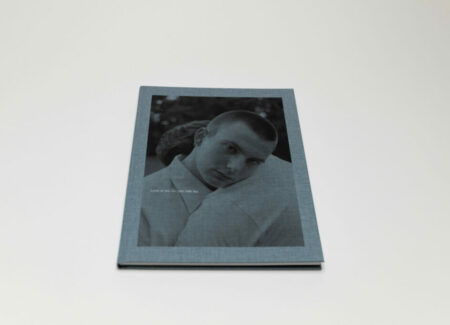JTF (just the facts): Published in 2022 by MACK Books (here). Hardcover (23.5 x 29.5 cm), 108 pages, with 60 color photographs. Includes various texts by the artist. Design by Morgan Crowcroft-Brown. The monograph was shortlisted for the 2022 the Paris Photo–Aperture PhotoBook Award. (Cover and spread shots below.)
Comments/Context: Jess T. Dugan, who identifies as a queer, nonbinary, has been using photography since their teenage years to understand their own identity and to find a deeper emotional connection with others. Dugan’s new photobook titled Look at me like you love me brings together a collection of self-portraits, thoughtfully mixed with portraits of individuals, couples, and occasional still lifes and paired with the artist’s very personal writings. Dugan shares that “from a very young age, I felt compelled to make images of queer people, including myself, that were as nuanced and complex and beautiful as I knew these individuals to be.” The new book offers a poetic narrative of love, tenderness, and desire, all in an act of seeing and being seen.
The photographs in Look at me like you love me are part of the artist’s long-term project Every Breath We Drew, which examines “the intersection of individual identity and the need for connection with others.” Most of the photographs were shot in the past few years, and capture a specific moment in Dugan’s life and practice. A selection of photographs from the photobook was also recently on view at CLAMP Gallery in New York (from November 7, 2022 through January 7, 2023, here), and the intimate space of the gallery worked particularly well for the series. (Installation shots below.)
Look at me like you love me is elegant and straightforward as a photobook. It has a blue linen cover, with an image of Oscar gently resting his head on Zach’s shoulder while looking straight into the camera that takes up most of the available space. The title, in a small silver font, appears embossed on the image, connecting the two together and setting the mood for its content. Inside, the visual flow consists of photographs of various sizes with generous white space around them. Dugan’s writings appear throughout the book, with images or separately, providing additional layers of context and emotion. An image grid of captions that indicates the sitters’ names and the year the photos were taken is placed at the very end, closing the book.
The book opens with a medium size self-portrait titled “Self-portrait (blue room), 2021”. In it, Dugan poses in a hoodie and jeans against a blue background, their eyes are closed, their arms are behind their back and their chest is open. Right from the beginning, this gentle and confident portrait sets the mood for the series. The following spread pairs the first occasion of Dugan’s writing and an image of pink irises in a vase. Dugan’s words offer the direction, “I want to tell you things; I want you to know my story. There is so much I can’t say in my photographs, though it’s all there, just below the surface, if you know what to look for.” Dugan uses still lifes throughout the book for setting the mood and adding moments of stillness.
Dugan’s portraits are usually simply staged (taken both in the comfort of an apartment and nature), and use available natural light, directing our full attention to the people. The individuals depicted in Dugan’s series vary in class, race, age, gender identity, and sexual orientation. In these carefully composed photos, the sitters usually look straight into the camera, as they share their internal world and vulnerability. The photographs are sequenced based on commonalities of gesture and color, creating a thoughtful and emotional visual narrative.
Dugan has built trusted and collaborative relationships with her subjects, and they consistently look comfortable and relaxed. Some people are depicted alone, in moments of solitude, others with their loved ones. The portraits, starting with the very first one on the cover, often capture people gently embracing, and those moments are full of closeness, connection, and intimacy. In these pictures, couples entwine their bodies in beds or hug outside, and other subjects are floating peacefully in the water or relaxing in a bathtub, and a few photographs reveal top-surgery scars. All of them portray people with grace and respect, with Dugan using photography to empower their subjects.
The book also ends with a self-portrait, a slightly larger one. This time Dugan stands shirtless with eyes closed, pushing their chin up and extending their arms up, with calming water and sky behind. This photograph, free, peaceful and assertive, stands as a fitting closure to the narrative.
As a photobook object, Look at me like you love me is an elegant and straightforward publication. With its empathy and respect, it shows how visual representation, and portraiture in particular, can be powerful (and empowering) in sharing experiences and connecting with others. The depiction of the sitters is particularly attentive and fresh, digging deeper into the nuances of desire, intimacy, and the politics of looking. Dugan’s work is an important contribution into complex conversation about gender, identity and representation, challenging the ways we portray and perceive sexuality.
Collector’s POV: Jess T. Dugan is represented by CLAMP Gallery in New York (here) and Turner Carroll Gallery in Santa Fe (here). Their work has not consistently found its way to the secondary markets, so gallery retail remains the best option for those collectors interested in following up.






















